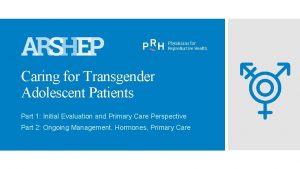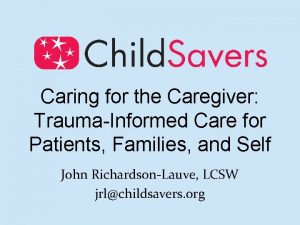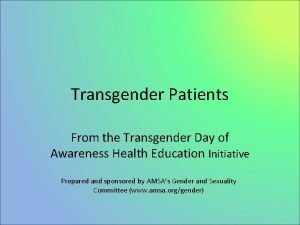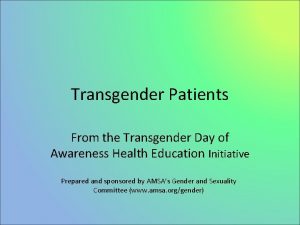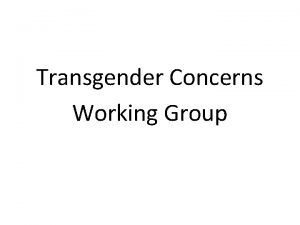Increasing Cultural Humility Working with Transgender Clients and









































































- Slides: 73

Increasing Cultural Humility: Working with Transgender Clients and Patients Jaysa P. Jones, MSW-LCSW

Goal of the Workshop • To define cultural competence, humility, proficiency and identify & incorporate practices that engage and retain Transgender individuals in care • To identify at least 2 strategies for culturally effective interactions and at least one practice behavior that will be used after the training

Defining Transgender

Defining Transgender: What do we mean when we say, “transgender? ” – Refers to a person whose gender identity does not correspond to their sex assigned at birth. – Transgender (or the shortened version, ‘trans’) may be used to refer to an individual person’s gender identity and is sometimes used as an umbrella term for all people who do not conform to traditional gender norms. (Keatley, Deutsch, Sevelius & Gutierrez-Mock, 2015)

Defining Transgender: • Trans Umbrella – Trans man (FTM) – Female – Trans woman (MTF) – Genderqueer – Additional regional/ – Gender non-conforming cultural terms – Male

Defining Transgender: It is important for providers to understand the four core concepts of trans identity: Sex Assigned at Birth Gender Identity Gender Expression Sexual Orientation

Defining Transgender: It is critically important for providers to respect and use trans clients names & pronouns: – Preferred names and/or pronouns may change and may not match current identity documents. – Ask clients name and pronoun preference. – Use client’s preferred name and pronouns.

Defining Transgender: Respecting trans clients names & pronouns cont. : – Examples: • Gendered pronouns: – Include he/his; she/her. • Gender neutral pronouns: – Include they/them; ze/hir

Defining Transgender: How many trans people exist in our society? . 1% • California LGBT Tobacco Use Survey (2003 & 2004) . 2% • Los Angeles County (2012) – estimate . 3% • San Francisco County (2011) – estimate • Williams Institute (2011) – average of previous studies . 5% • Massachusetts landline survey (Conron, Scott, Stowell & Landers, 2012)

Related Health Issues for Trans Individuals

Related Health Issues for Trans Individuals: Sexual and Reproductive Health: • Transgender people might have sexual partners who are men, women or both – A transgender person’s sexual history cannot be assumed based on their gender identity or sex assigned at birth. (Stieglitz, 2010; Gamarel, et al. , 2016) • Transgender people who have sex with men are at risk for unintended pregnancy as well as STIs. – Transgender men who have sex with men report high rates of unprotected vaginal and anal intercourse (Gamarel, et al. , 2016; Reisner, et al. , 2010)

Related Health Issues for Trans Individuals: Sexual and Reproductive Health Cont. : • Transgender people may be reluctant seeking sexual and reproductive health care. – A study showed that one in three transgender people, and 48% of transgender men, have delayed or avoided seeking preventive health care such as pelvic exams or STI screening due to fear of discrimination and insolence. (Grant, et al. , 2010)

Related Health Issues for Trans Individuals: Trans people and substance use: 69% • Trans female youth reported recent substance use. (Rowe, Santos, Mc. Farland & Wilson, 2015) • This study was carried out in San Francisco Bay Area 76% • Trans women reported recent substance use. (Nuttbrock et al. , 2014) • This study was carried out in New York Metropolitan Area 70% • Trans men reported current substance use. (Reisner, White, Mayer & Mimiaga, 2014) • This study was carried out at a Boston, Massachusetts Area Health Center

Related Health Issues for Trans Individuals: Factors associated with substance use among trans people: – Depression – PTSD – Sex work (Nuttbrock et al. , 2014) (Rowe et al. , 2015) (Hoffman, 2014; Birth-Melander et al. , 2010) – Gender-related discrimination (Rowe et al. , 2015; Reisner, Gamarel, Nemoto & Operario, 2014; Nuttbrock et al. , 2014)

Related Health Issues for Trans Individuals: Cross-Sex Hormone Therapy (cs. HT): – Not all trans people desire cs. HT and/or surgical intervention. – cs. HT is safe, with few long-term side effects. (Asscheman, T’Sjoen & Gooren, 2014). – cs. HT is not contra-indicated for HIV antiretroviral therapy (ART). (Center of Excellence for Transgender Health, 2011). – Clients should be allowed to continue (or start) cs. HT in treatment programs.

Related Health Issues for Trans Individuals: Trans People and HIV/AIDS: 28% • Average self-report by trans women across the US was 12% • 56% among Black trans women • Herbst et al. , 2007 22% • U. S. results for trans women from a global meta-analysis • Baral et al. , 2013 0 -3% • Self-reported HIV rates among trans men in various cities such as Philadelphia, Washington D. C. , San Francisco etc. • Sevelius et al. , 2009

Related Health Issues for Trans Individuals: Trans People and HIV/AIDS cont. : – MTF transgender youth of color have many unmet needs and are at extreme risk of acquiring HIV/AIDS. “Although limited data exist on the experiences of transgender youth from communities of color, anecdotal evidence suggests that they are not only at risk of acquiring HIV, but also face enormous challenges navigating adolescent and gender identity development without readily available, culturally appropriate health care and social support services. ” (Garafolo et. al. , 2006)

Related Health Issues for Trans Individuals: Mental health: – Trans people report significantly worse mental health than non-trans people. (Newfield, Hart, Dibble & Kohler, 2006; Reisner et al. , 2014) – Negative mental health outcomes are associated with transphobia, including physical and psychological abuse and family rejection. (Nuttbrock et al. , 2014; Simons et al. , 2013)

Related Health Issues for Trans Individuals: Mental health cont. : – Hormone therapy improved quality of life scores among a sample of trans men. (Newfield, Hart, Dibble & Kohler, 2006)

Related Health Issues for Trans Individuals: Hormone Blockers: – Used to treat children who are transgender or gender non-conforming. The medications suppresses the body’s production of estrogen or testosterone, and essentially pause the changes that would occur during puberty. – The Endocrine Society’s guidelines suggest starting puberty blockers for transgender children around 10 or 11 years old for a girl and 11 or 12 years old for a boy. (Ehrensaft, 2009; Hembree, et al. , 2009; Zucker, et al. , 2010)

Related Health Issues for Trans Individuals: Gender Confirming/Affirming Surgery: – This is an irreversible surgical procedure used in changing genital organs from one sex to another. – Male to female genital surgery have been found to be generally more successful and less risky compared to female to male genital surgery. – Clients exposed to such procedures are at increased risk for myocardial infarction, bleeding and mortality, cervical cancer, cardiovascular disease, suicidal behavior, psychiatric morbidity than the general population. (Wroblewski, et al. , 2013; Tangpricha, 2015; Weinand & Safer, 2015)

Related Health Issues for Trans Individuals: Assault: – A 2011 national survey titled, “Injustice at Every Turn” surveyed 6450 transgender and non-gender conforming people: • 71% of multiracial respondents reported having experienced bullying, physical abuse, sexual assault, harassment, and even expulsion from school. • When comparing these types of abuses in different geographical areas, 58 -65% of transgender and non-gender conforming people had experienced assault. (Grant, Mottet, & Tanis, 2011)

Related Health Issues for Trans Individuals: Assault cont. : • A critical finding from the survey concluded transgender and gender non-conforming people of color experience particularly devastating levels of discrimination when anti-transgender bias is combined with structural and interpersonal racism. (Grant, Mottet, & Tanis, 2011)

Provider Considerations

Provider Considerations: Policy Community Institutional Interpersonal Intrapersonal

Provider Considerations: What does intrapersonal stigma and transphobia look like? – Internalized transphobia – Low self-esteem – Depression and self-harm – Gender identity validation through external sources

Provider Considerations: What does interpersonal stigma and transphobia look like? – Family rejection – Peer harassment/bullying – Harassment from co-workers – Rejection from potential romantic/sexual interests

Provider Considerations: What does institutional stigma and transphobia look like? – Access to Comprehensive Health care – Educational settings – Employment discrimination – Housing discrimination – Correctional settings – Religion

Provider Considerations: • What does community stigma and transphobia look like? – Violence – Norm of substance use – Norm of sex work – Social stigma

Provider Considerations: • What does policy stigma and transphobia look like? – Trans panic defense – Non-Discrimination Policies – Name and gender changes – Immigration laws

United States Nondiscrimination Laws: • Dark Green: States banning discrimination based on sexual orientation and gender identity (20 states and District of Columbia). • Light Green: Laws banning discrimination based on sexual orientation (2 states).

Provider Considerations: It is important to highlight protective factors against negative health outcomes associated with transphobia: Policy Community Institutional Interpersonal Intrapersonal • Non discrimination policies (employment, schools, public accommodations, etc. ) • Community involvement • Community acceptance • Competent health care providers • Education of police • Social support • Family acceptance • Self esteem • Gender affirmation

Provider Considerations: “Intersectionality” can help describe the intersections between race, culture and gender: – Promotes an understanding of human beings as shaped by interaction of different social locations. – Interactions take place within structures of power and systems. – Inequities such as racism, transphobia, prejudice, etc… result from the intersections of different social factors, power dynamics and experiences. (Hankivsky 2014)

Provider Considerations: • Intersectionality Gender Race/ ethnicity Sexuality Class

Provider Considerations: Service delivery clinical considerations: – Gender segregated facilities – Identity documents – Staff competence – Appropriate clinical assessment versus curiosity/ignorance – Bullying/victimization from other clients – Electronic health records

Provider Considerations: Provider recommendations: – A client’s anatomy should only be discussed if relevant to their treatment. – Provide care for anatomy that is present while affirming the patient’s current gender identity. (Center of Excellence for Transgender Health, 2011).

Provider Considerations: Provider recommendations cont. : – The Center of Excellence for Transgender Health makes the following recommendation for trans-inclusive data collection: • Asking current gender identity • Asking assigned sex at birth (Center of Excellence for Transgender Health, 2011)

Provider Considerations: CETH Recommended Trans/Gender Expression Inclusive Intake Questionnaire 1. What is your current gender identity? (Check and/or circle ALL that apply) ☐ Male ☐ Female ☐ Transgender Male/Transman/FTM ☐ Transgender Female/Transwoman/MTF ☐ Genderqueer ☐ Additional category (please specify): ________________ ☐ Decline to answer 2. What sex were you assigned at birth? (Check one) ☐ Male ☐ Female ☐ Decline to answer 3. What are your pronouns do you use? ____________

Provider Considerations: In treatment programs, trans clients report: – Experiencing more transphobia from treatment program staff than from other clients. – Programs do not address trans issues. – Being required to use sleeping and shower facilities inconsistent with their current gender identity.

Provider Considerations: Provider recommendations cont. : – Educate treatment program staff and enforce policy. – Allow trans clients to use bathrooms, showers and sleeping facilities based on their current gender identification. – Allow trans clients to continue the use of hormones in treatment. – Advocate for trans client using “street” hormones to receive immediate medical care and legally prescribed hormones.

Provider Considerations: Provider recommendations cont. : – Seek clinical supervision if there are issues or feelings about working with trans individuals. – Post a nondiscrimination policy in the waiting room that explicitly includes sexual orientation and gender identity.

Discussion Exercise: In small groups or in a pair, answer the following question, record notes, and share with the larger group: • What do you or your organization need in order to build, enhance, and refine services for trans clients?

Cultural Humility

What Is …an integrated pattern of human behavior that includes thoughts, communications, languages, practices, beliefs, values, customs, courtesies, rituals, roles, relationships, manners of interacting, and expected behaviors of a racial, ethnic, religious or social group. National Center on Cultural Competence, http: //www. nccccurricula. info/glossary. html

Dynamics of Culture 45

Cultural Patterns Can be used to understand groups of people These patterns are not frozen, or static, but open to exceptions since many individuals have experiences that are not shared by their group.

Cultural Competence A set of congruent behaviors, attitudes, and policies that come together in a system, agency, or among professionals that enables effective work in cross-cultural situations US Department of Health & Human Services, Office of Minority Health, http: //minorityhealth. hhs. gov/templates/browse. aspx? lvl=2&lvlid=11

“Cultural Humility” Perspective “Lifelong process of learning, self-examination & refinement of one’s own awareness, knowledge, behavior and attitudes on the interplay of power, privilege and social contexts” Tervalon, M. & Murray-Garcia, J. (1998, Journal of Health Care for the Poor and Underserved, 9(2), 117

Male Female? Cisgender Unconscious Gay or or or. Straight? Transgender? Bias Gender Shock: Exploding the Myths of Male and Female Book by Phyllis Burke

Conditioning - Activity • Large group activity • Follow trainer’s instructions

Perceptions Paradigm • Cues • Filters • Perceptions • Assumptions • Behavior

Conceptual Framework Adapted from a Treatment Improvement Protocol, Improving Cultural Competence, TIP 59 http: //store. samhsa. gov/shin/content//SMA 14 -4849. pdf

Cultural Proficiency • Cultural proficiency is the knowledge, skills, attitudes and beliefs that enable people to work well with, respond effectively to, and be supportive of people in cross-cultural settings. • Critical to the engagement & retention of LGBT people – Can help practitioners begin to address individual and societal history; e. g. , experiences of murder, violence, rejection, degradation, & discrimination

PRACTICE STRATEGIES 54 54

Practitioner Awareness - YOU • Consciousness of one's personal reactions to people who are culturally different. • Social science research indicates that our values and beliefs may be inconsistent with our behaviors, and we ironically may be unaware of it. Kirwan Institute, Implicit Bias http: //kirwaninstitute. osu. edu/wp-content/uploads/2014/03/2014 -implicit-bias. pdf

You Have a Choice Cultural Humility requires choice & action choosing to enhance cultural proficiency, adding to knowledge base, personal and professional introspection, checking for assumptions and bias, engaging in consistent practice assessment, seeking and using supervision & support, exposure/interaction with populations, choosing to take professional and culturally competent actions to promote health and goal attainment for all individuals, • acknowledgement and investigation of less culturally competent practice, • willingness & fortitude to engage in an on-going process • •

Quote to Remember “Be open to someone's individuality. Just because you’ve worked with one _____, doesn’t mean the next _____ will be just like them”. Diana Padilla, Cultural Expert, Program Manager, Ne. C-ATTC, NDRI-USA

Culturally Informed Strategies • Refrain from making assumptions • Recognize that as human beings, our brains make assumptions without us even knowing it • Communication can be as unique as a person’s cultural perspective • Support & encourage positive images of persons of color, YMSM, women, LGBT, gender variant/non conforming, elderly, other abled, and not written here, in conversation and all environments

KEY CONCEPT Cultural humility requires consistent re-self-appraisal; check in with yourself… forever

Minority Stress Theory Examines the ways in which the unique stressors experienced by minority individuals may relate to mental health disparities in health (Meyer, 2003).

Minority Stress Theory • Suggests that sexual minority individuals are at greater risk for health problems than heterosexuals, because of the greater exposure to social stress related to prejudice and stigma. • Prejudice-related stressful life events have a unique deleterious impact on health that persists above and beyond the effect of stressful life events unrelated to prejudice. Frost, Lehavot, & Meyer, 2013 • Sexual and gender minorities of color experience higher levels of minority stressors • Sexual identity or non-sexual identity is inseparable from other identities (e. g. race/ethnicity, gender) Balasam, Molina, Beadnell, Simoni, & Walthers, 2011

Impact of Minority Stress Sexual Minority Gender Minority Racial/Ethnic Minority Individual

From Minority Stress Factors to Resiliency and Coping 63

Resiliency & Coping • Some studies on resilience and coping found some LGBT people of color do not show negative additive effects of discrimination • It is possible that LGBT people of color, having experienced discrimination as racial/ethnic minorities, may have learned more ways of coping with discrimination, which benefits them when experiencing it based on being a sexual minority

Coping Strategies • Extrapolating from the coping strategies of other sexual minorities (e. g. , LGBT) • Creating and/or being members of a strong community • Using social networks both interpersonal and digital (social media) • Managing discrimination – Determine if it is threatening – Determine if resources are available to counter it – Talking about it with others

Specific Recommendations • Recognize minority stress as a factor that may impact health outcomes for sexual minorities • Understand that for trans individuals of color there may be *triple jeopardy* (race/ethnicity + sexual + gender minority stress) • Assess for minority stress factors in order to validate and provide space for LGBT to address the minority stress explicitly

Summary • Minority stress is experienced by racial/ethnic, sexual, and gender minorities that may relate to mental and physical health disparities • Providers can have a positive impact based on principles of selfawareness, cultural humility, and client resiliency

Questions and Comments?

Resources: • • • GLAAD Transgender Resources: http: //www. glaad. org/transgender/resources Transgender Foundation of America: http: //www. tgctr. org/about/ National Center for Transgender Equality: http: //transequality. org/ Transgender Care Health Information Archive: http: //www. transgendercare. com/medical/resources/ Center of Excellence for Transgender Health: http: //transhealth. ucsf. edu/trans? page=protocolevidence • • American Congress of Obstetricians and Gynecologists: Women’s Health Care Physicians: Health Care for Transgender Individuals: http: //www. acog. org/Resources -And-Publications/Committee-Opinions/Committee-on. Health-Care-for-Underserved-Women/Health-Care-for. Transgender-Individuals Transgender Health Services Working Group, City and County of San Francisco. (2007). Transgender HIV Health Services Best Practices Guidelines. Accessed online January 15, 2010 from: http: //careacttarget. org/library/tgguidelines. pdf

References: • • • Asscheman, H. , T'Sjoen, G. G. & Gooren, L. J. (2014). Morbidity in a Multisite Retrospective Study of Cross-Sex Hormone-Treated Transgender Persons. Endocrine Society’s 96 th Annual Meeting and Expo. Presentation number: OR 423. Downloaded on 3/12/2015 from http: //press. endocrine. org/doi/abs/10. 1210/endo-meetings. 2014. RE. 2. OR 42 -3. • Baral, S. , Todd, C. , Aumakhan, B. , Lloyd, J. , Delegchoimbol, A. , & Sabin, K. (2013). HIV among female sex workers in the Central Asian Republics, Afghanistan, and Mongolia: Contexts and convergence with drug use. Drug and Alcohol Dependence, 132(1), S 13 -S 16. doi: 10. 1016/j. drugalcdep. 2013. 07. 004 • Birth-Melander, P. , Sheoran, B. , Sheth, L, Bermudez C, Drone J, Wood W, Schroeder K. (2010). Understanding sociocultural and psychological factors • affecting transgender people of color in San Francisco. The Journal of the Association of Nurses in AIDS Care: JANAC, 21(3): 207 -20. California Department of Health Services, Tobacco Control Section. (2004). Lesbians, Gays, Bisexuals, and Transgender Tobacco Use Survey: prepared by • the Field Research Corporation, san Francisco, CA. Retrieved from http: //citesource. trincoll. edu/apagovreportweb. pdf • Center of Excellence for Transgender Health (2011). Primary Care Protocol for Transgender Patient Care. University of California, San Francisco, Department of Family and Community Medicine. Downloaded on 3/12/2015 from http: //transhealth. ucsf. edu/trans? page=protocol-00 -00. Conron, K. J. , Scott, G. , Stowell, G. S. , & Landers, S. J. (2012). Transgender health in Massachusetts: Results from a household probability sample of adults. American Journal of Public Health, 102(1), 118 -122. Doi: 10. 2105/AJPH. 2011. 300315 Ehrensaft, D. (2009). One pill makes you boy, one pill makes you girl. International Journal of Applied Psychoanalytic Studies, 6(1), 12 -24. Fredriksen-Goldsen, K. I. , Cook-Daniels, L. , Kim, H. J. , Erosheva, E. A. , Emlet, C. A. , Hoy-Ellis, C. P. , Goldsen, J. & Muraco, A. (2014). Physical and mental health of transgender older adults: an at-risk and underserved population. The Gerontologist, 54(3): 488 -500. Garofalo, R. , Deleon, J. , Osmer, E. , Doll, M. & Harper, G. W. (2006). Overlooked, misunderstood and at-risk: exploring the lives and HIV risk of ethnic minority male-to-female transgender youth. Journal of Adolescent Health, 38(3): 230 -6. Gates, G. J. (2011). How many people are lesbian, gay, bisexual, and transgender? The Williams Institute. Retrieved from http: //williamsinstitute. law. ucla. edu/wp-content/uploads/Gates-How-Many. People-LGBT-Apr-2011. pdf

References: • • Grant, J. M. , Mottet, L. A. , Tanis, J. , Herman, J. L. , Harrison, J. , & Keisling, M. (2010). National Transgender Discrimination Survey Report on health and health care. National Center for Transgender Equality and National Gay and Lesbian Task Force. Washington, DC, 1 -23. Grant, J. M. Mottet, L. A. Tanis, J. Harrison, J. , Herman, J. L. & Keisling, M. (2011). Injustice at every turn: A report of the National Transgender Discrimination • Survey. National Center for Transgender Equality & National Gay and Lesbian Task Force. • Hembree, W. C. , Cohen-Kettenis, P. , Delemarre-van de Waal, H. A. , Gooren, L. J. , Meyer III, W. J. , Spack, N. P. , . . . & Montori, V. M. (2009). Endocrine treatment of transsexual persons: an Endocrine Society clinical practice guideline. The Journal of Clinical Endocrinology & Metabolism, • 94(9), 3132 -3154. • • Herbst, J. , Jacobs, E. , Finlayson, T. , Mckleroy, V. , Neumann, M. , & Crepaz, N. (2007). Estimating HIV Prevalence and Risk Behaviors of Transgender Persons in the United States: A Systematic Review. AIDS and Behavior, 12: 1 -17. Retrieved • June 30, 2015. • Hoffman, B. R. (2014). The interaction of drug use, sex work, and HIV among transgender women. Substance Use & Misuse, 49(8): 1049 -53. Keatley, J. G. , Deutsch, M. B. , Sevelius, J. M. , Gutierrez-Mock, L. (2015). Creating a foundation for improving trans health: Understanding trans identities and health care needs. In Makadon, H. J. , Mayer, K. H. , Potter, J. , Goldhammer H. (Eds), The Fenway Guide to Lesbian, Gay, Bisexual, and Transgender Health 2 nd Edition (pp. 459 -478). Philadelphia, PA: American College of Physicians Lombardi, E. (2007). Substance use treatment experiences of transgender/transsexual men and women. Journal of LGBT Health Research, 3(2): 37 -47. Los Angeles County Department of Public Health. (2012). Transgender Population Estimates. Retrieved from https: //admin. publichealth. lacounty. gov/aids/reports/Transgender. Population. E stimates 2 -12 -13. pdf Mc. Guire, J. K. , Anderson, C. R. , Toomey, R. B. & Russell, S. T. School climate for transgender youth: a mixed method investigation of student experiences and school responses. Journal of Youth and Adolescence, 39(10), 1175 -1188. National LGBTQ Task Force (2014). State Nondiscrimination Laws in the U. S. Retrieved from http: //www. thetaskforce. org/ Newfield, E. , Hart, S. , Dibble, S. & Kohler, L. (2006). Female-to-male transgender quality of life. American Journal of Public Health, 104(11): 2191 -8.

References: • • • Nuttbrock, L. , Bockting, W. , Rosenblum, A. , Hwahng, S. , Mason, M. , Macri, M. & • Becker, J. (2014). Gender abuse, depressive symptoms, and substance use among transgender women: a 3 -year prospective study. American Journal of Public Health, 104(11): 2199 -206. • Persson, DI. (2009). Unique challenges of transgender aging: implications from the literature. Journal of Gerontology in Social Work, 52(6): 633 -46. Reisner, S. L. , Gamarel, K. E. , Nemoto, T. & Operario D. (2014). Dyadic effects of • gender minority stressors in substance use behaviors among transgender women and their non-transgender male partners. Psychology of Sexual Orientation and Gender Diversity 1(1): 63 -71. Reisner, S. L. , Perkovich, B. , & Mimiaga, M. J. (2010). A mixed methods study of the sexual health needs of New England transmen who have sex with nontransgender men. AIDS patient care and STDs, 24(8), 501 -513 Reisner, S. L. , • White, J. M. , Mayer, K. H. & Mimiaga, M. J. (2014). Sexual risk behaviors and psychosocial health concerns of female-to-male transgender men screening for STDs at an urban community health center. AIDS Care, 26(7): 857 -64. • Reisner, S. L. , Greytak, E. A. , Parsons, J. T. & Ybarra, M. L. (2014). Gender minority social stress in adolescence: disparities in adolescent bullying and substance use by gender identity. Journal of Sex Research, 52(3): 243 -56. Rowe, C. , Santos, G. M. , Mc. Farland, W. & Wilson, E. C. (2015). Prevalence and correlates of substance use among trans female youth ages 16 -24 years in the San Francisco Bay Area. Drug and Alcohol Dependence, 147: 160 -6. Ryan, C. , Russell, S. T. , Huebner, D. , Diaz, R. & Sanchez, J. (2010). Family acceptance in adolescence and the health of LGBT young adults. Journal of Child and Adolescent Psychiatric Nursing, 23(4): 205 -13. Sevelius J. ‘‘There’s no pamphlet for the kind of sex I have’’: HIV-related risk factors and protective behaviors among transgender men who have sex with non-transgender men. Journal of the Association of Nurses in AIDS Care. 2009; 20: 398 -410. - See more at: http: //caps. ucsf. edu/archives/factsheets/transgendermen#sthash. 2 QDpt. C 8 G. dpuf Simons, L. , Schrager, S. M. , Clark, L. F. , Belzer, M. & Olson, J. (2013). Parental support and mental health among transgender adolescents. Journal of Adolescent Health, 53(6): 791 -3. Siverskog A. (2014). "They Just Don't Have a Clue": Transgender Aging and Implications for Social Work. Journal of Gerontology in Social Work, 57(2 -4): 386406.

References: • • • Stieglitz, K. A. (2010). Development, risk, and resilience of transgender youth. Journal of the Association of Nurses in AIDS Care, 21(3), 192 -206. Tangpricha, V. (2015). Safety of transgender hormone therapy. Journal of Clinical & Translational Endocrinology, 2(4), 130. Weinand, J. D. , & Safer, J. D. (2015). Hormone therapy in transgender adults is safe with provider supervision; A review of hormone therapy sequelae for transgender individuals. Journal of Clinical & Translational Endocrinology, 2(2), 55 -60. Witten, T. M. (2014). End of life, chronic illness, and trans-identities. Journal of Social Work in End-of- Life & Pallative Care, 10(1): 34 -58. Wroblewski, P. , Gustafsson, J. , & Selvaggi, G. (2013). Sex reassignment surgery for transsexuals. Current Opinion in Endocrinology, Diabetes and Obesity, 20(6), 570 -574. Zucker, K. J. , Bradley, S. J. , Owen-Anderson, A. , Singh, D. , Blanchard, R. , & Bain, J. (2010). Puberty-blocking hormonal therapy for adolescents with gender identity disorder: A descriptive clinical study. Journal of Gay & Lesbian Mental Health, 15(1), 58 -82.
 True humility vs false humility
True humility vs false humility Fnha cultural safety and humility
Fnha cultural safety and humility Cultural humility definition
Cultural humility definition Cultural humility ted talk
Cultural humility ted talk Cultural humility
Cultural humility Proverbs on pride and humility
Proverbs on pride and humility Patience sermon outline
Patience sermon outline What does god say about transgender
What does god say about transgender Transgender economic empowerment project
Transgender economic empowerment project Genogram symbols
Genogram symbols Transgender umbrella
Transgender umbrella Ihsa transgender policy
Ihsa transgender policy Before mount everest was discovered riddle answer
Before mount everest was discovered riddle answer Transgender
Transgender Cavaria genderkoek
Cavaria genderkoek What is transgender
What is transgender Transgender
Transgender Hot working and cold working difference
Hot working and cold working difference Hot hot
Hot hot Differentiate between hot working and cold working
Differentiate between hot working and cold working Proses pengerjaan panas
Proses pengerjaan panas Biblical definition of humility
Biblical definition of humility What knee do you genuflect on
What knee do you genuflect on Clothe yourselves with humility
Clothe yourselves with humility Unity through humility
Unity through humility Jesus walks on water luke
Jesus walks on water luke Philippians 2:1-30
Philippians 2:1-30 The competent manager
The competent manager Set aside prayer
Set aside prayer Biosphere 2 a lesson in humility
Biosphere 2 a lesson in humility Bi vs dss
Bi vs dss Web essentials clients servers and communication
Web essentials clients servers and communication Working smart vs working hard
Working smart vs working hard Today's public relations departments
Today's public relations departments Recruiting call script
Recruiting call script Déontologie
Déontologie Flux de données clients
Flux de données clients Typologie des clients insatisfaits
Typologie des clients insatisfaits Ibm thin clients
Ibm thin clients How to schedule appointments with clients
How to schedule appointments with clients Trauma-informed questions for clients
Trauma-informed questions for clients Assessment questions for social workers
Assessment questions for social workers Nudge for clients
Nudge for clients Circles of my multicultural self
Circles of my multicultural self Characteristics of profession
Characteristics of profession Adlerian theory key concepts
Adlerian theory key concepts Courtland c lee
Courtland c lee Prospecting and qualifying
Prospecting and qualifying What are two important requirements for a healthy scalp
What are two important requirements for a healthy scalp Clients needs assessment
Clients needs assessment Gnutella file sharing
Gnutella file sharing Thin client nachteile
Thin client nachteile How should you handle tardy clients
How should you handle tardy clients Idt clients
Idt clients Facade pattern couples a subsystem from its clients
Facade pattern couples a subsystem from its clients Ucm appipay
Ucm appipay Aims and objectives of increasing and decreasing functions
Aims and objectives of increasing and decreasing functions Ordinary language meaning
Ordinary language meaning How to find increasing and decreasing intervals on a graph
How to find increasing and decreasing intervals on a graph Increasing function
Increasing function Removable and non removable discontinuities
Removable and non removable discontinuities Britain diamond mining and increasing labour control
Britain diamond mining and increasing labour control Lesson 4 increasing and decreasing functions
Lesson 4 increasing and decreasing functions First derivative increasing decreasing
First derivative increasing decreasing Strictly increasing and decreasing functions
Strictly increasing and decreasing functions Increasing intervals
Increasing intervals Increasing decreasing and piecewise functions
Increasing decreasing and piecewise functions Increasing and decreasing recipes
Increasing and decreasing recipes Increasing and decreasing intervals parabola
Increasing and decreasing intervals parabola Explain pictures
Explain pictures Atoms in increasing size
Atoms in increasing size Electromagenetic spectrum
Electromagenetic spectrum Increasing at a decreasing rate
Increasing at a decreasing rate Increasing friction
Increasing friction
















